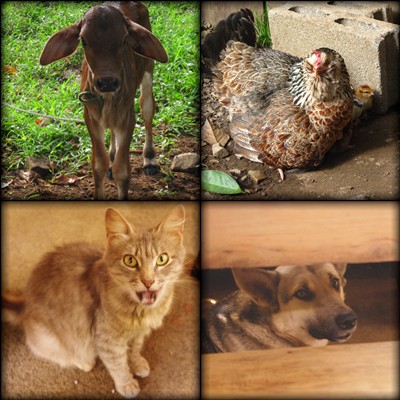Estelí
It took me a long time to get used to living in Managua but after a month and a bit in Estelí, I already feel really at home. This is the city, nestled between mountains. It's quite flat so on almost any street you can see the mountains, it's comforting in a strange way. This is the north central highlands, and feels a million miles away from Managua, but it's only a bit more than 2 hours on the express bus.
There's a husky puppy (six months and giant) in the house I live in, we go wandering the streets at around 6pm most evenings when it's quite cool and the light is turning orange and red over the hills, it's my favourite time of day. People have their doors open and sit on their doorsteps chatting or in rocking chairs on the patio watching the world go by. It feels really safe here. Until a ferocious dog throws itself at the gate of a house and scares me and Saskia to death.
Estelí was where a lot of the fighting took place during the revolution in the 1970s, there are lots of murals around town supporting the revolution and remembering many of the compañeros from here who died. This is a more recent one showing the current president who is from the Sandinista party that led the revolution.
Jumping to another subject, here are a couple of photos from a nature reserve nearby, Tisey-Estanzuela. This mirador (viewpoint) was just ten minutes walk from the cabin on a farm that we stayed in for a night. We were told sometimes you can see over the border to Honduras and to the coast the other way, but it was a bit hazy while we were there. Still, not too bad a view. We could see a few different volcanoes as well.
This one was taken from the bus on the way up. The coating against the sun on the windows gave it the sepia kind of effect, a nice surprise! There's lots of cattle farms along the Panamerican highway and you often see the cowboys herding them along the side of the road.
The project
I'll try and explain a bit about what I'm doing here, apart from hanging out with a husky and improving my Spanish by drinking beer and chatting to people.
There is a non-profit social enterprise here that uses funds from a hostel and (very nice) café to run projects in the Miraflor Protected Area, which is about 45 minutes. It's been going for quite a few years and does micro-loans for house-building/improving, an organic gardens project, a library bus for children in the reserve which is just about to start running next week, and eco-tourism with families in the reserve who take in tourists to stay with them for some extra income. It works directly with the communities in the reserve and only employs local people. They want to start using some money raised from the tourism office and homestays to do conservation, as Miraflor has been downgraded from reserve to protected area and has been heavily deforested. So my job, and another volunteer who has just joined me, is to help plan this and work with the employees here to get trees planted in May/June when the rainy season has begun. We want this to become a sustainable, ongoing activity for the communities involved so we're planning a program of environmental education for the children at school to get them interested and enthusiastic about the benefits of reforestation.
I'm learning lots about tropical tree species and traditional agriculture techniques where selecting certain species of trees can help improve your crops and even cattle in so many ways, it's incredible! Need to get myself a big garden to practice for myself in.
There's a LOT to do but there's loads of people, local and foreign around here who can help us, and want to. I'll put more information and photos on here, as it happens, hopefully sooner rather than later!
This photo is taken from one of the two tree nursery sites, we're looking forward to spending some time up there after working a lot from computers here! This one is in the lower, dry zone, and the other nursery is in the high, humid zone which is cooler and a lot more green.
Ariel, on the left in the photo below, works in the tourism office and took me for a visit to the site this week on his motorbike. His family have land all around the site and we dropped in on his grandparents because he needed to help his grandad brand three calves. I definitely learned something new watching that! I wasn't sure I wanted to watch the actual branding but his grandma kept telling me to come over, she was pretty excited for me to see so I went and watched with her.
There was live music on this night and I got lots of salsa lessons, didn't learn much though due to all the nervous giggling I was doing. Loads of fun though, and much looser after a couple of mojitos.



































.JPG)
















